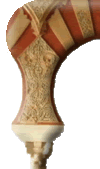


All praise is to one to whom all dignity, honour and glory are due; unique with perfect attributes. He has no equal but he is the Almighty. Sent his Messengers and Prophets to guide humanity towards monotheism and to worship him alone, the only one worthy of worship. Peace and blessings of Allah سبحانه التعالئ be upon all the prophets and messengers, especially on Prophet Muhammad صلى الله عليه و سلم the last of the Prophets and on all who follow him in righteousness until the day of recompense.
Preface
The Noble Qur`aan
is the last book of Allah سبحانه
التعالئ and His unaltered
revelation. This is why we are responsible of assuming the Noble Qur`aan
as our only true guide therefore we should be extremely meticulous about
all its judgments.
This is the only way for salvation both in this world and in hereafter.
We should explore the Noble Qur`aan very carefully and attentively about
what it relates to us and contemplate it.
Among the many Ahadith (traditions) of the Prophet صلى الله عليه و سلم, one particular Hadeeth which relates that the Noble Qur`aan is in three parts;
-
Tauhid, Monotheism, the most important so that we may understand the existence of Allah سبحانه التعالئ as a one true God.
-
Ahkaam, law and order, which make-up the Islamic Law or know as Shari`ah.
-
Qasas, events, the last part that completes the Noble Qur`aan are, past events of previous people, this is mentioned so that we may learn lessons form them and which consists a great part of the Noble Qur`aan. This is certainly one of the matters we ought to contemplate on.
And verily, we have sent among every Ummah (community, nation) a Messenger (proclaiming): 'Worship Allah (Alone) and avoid (or keep away from) Taghut (all false deities, do not worship Taghut besides Allah).' Then of them were some whom Allah guided and of them were some upon whom the straying was justified. So travel through the land and see, what was the end of those who denied (the truth). (Surah 16 An-Nahl, verse 36)
Introduction
One of the nations
that rejected their Prophets sent to them was the Ancient Egyptian.
All we know about them in history books nowadays is that they were once
a great civilization and one of the oldest discovered in the world,
along with other states established in Mesopotamia at the same time.
They were recognized to have been an organized state with the most advanced
social order of its age. The fact is that they discovered writing around
the 3rd millennium BC and also used it, that they made use of the River
Nile. River Nile greatly contributed to the Egyptians in improving their
civilization. They built what no man could ever imagine. The structures
which stood intact for more then three and half thousand years and is
the only sole survivor of the ancient, Seven Wonders of the World, the
'Pyramids'.
The question that still puzzles the human mind is that, how these colossal
structures were ever built, with their primitive technology and most
importantly why build them in first place.
In July 1798, Napoleon
apparently sat in the shadow of the Pyramids and calculated, that there
was enough stone used in the three Pyramids of Giza to be able to build
a wall around France, 1 ft wide and 12 ft high. The mathematician, Gaspard
Monge, who accompanied the French savants to Egypt, is to have confirmed
Napoleon's calculation.
Conventional wisdom suggests that the Pyramids were erected as tombs
for their dead kings and queens. It is true that granite sarcophagi
have been found in each of the three Pyramids of Giza, but there was
never evidence of burial. It is assumed that the Pyramids were looted
soon after their occupants were interred. But, again, there is practically
no evidence to support this.
Soon after conquering Egypt, Muslims were the first people to enter the Pyramids after they were permanently sealed. When the Caliph Al-Ma'mum and his workmen first broke into the inner chambers of the Great Pyramids in the ninth century CE, they found absolutely nothing. To gain access they had to first bore three enormous plugs of granite, which they had discovered accidentally. These clearly had not been disturbed since the pyramid was sealed up and they found no evidence of any burial or tombs. [1]
But this so called "civilized" society was one in which "the reign of pharaohs" prevailed, in which the system of infidelity is mentioned in the clearest and most straight forward way in the Noble Qur`aan. They puffed up with pride, turned aside and blasphemed. In the end, nether their advanced civilizations, their social and political orders, nor their military successes could save them from being destroyed.
How Does the Noble Qur`aan Relate to The Pyramids and Why Were They
constructed
In the Noble Qur`aan there are many events mentioned some in great detail
and some in not so much detail but there is no doubt that the most talked
about person in the Noble Qur`aan has to be Prophet Musa عليه
السلام. Whose events are
stretched out in 28 of the 30 parts of the Noble Qur`aan.
The events of Prophet Musa عليه السلام are not just mentioned in the Noble Qur`aan but also have been revealed by God in the old and new testaments. As one historian writes that the most talked about person in all the major religions has to be Prophet Musa عليه السلام or perhaps could be the most talked about person in history.
Among all these numerous events and confrontations mentioned regarding Prophet Musa عليه السلام and Fir'uan in the Noble Qur`aan, there is no verse which refers to the Pyramids directly. But in two of these verses marks an event of Fir'uan giving order to his chief to construct a lofty and very high tower, big enough that it could be called the biggest building of its time.

"Fir'uan (Pharaoh) said: "O chiefs! I know not that you have an Allah other then me. So kindle for me (a fire), 'O' Haman, to bake (bricks out of) clay, and set up for me a Srhan (a lofty tower or a palace) in order that I may (climb) look at (or look for) the Allah of Moses; and verily, I think that he (Moses) is one of the liars."
(Sura 28. Al-Qasas Section 4 Ayat 38)
In this verse, Fir'uan
says that there is no God but him self for the Egyptian people. To prove
this he had to some how show his people that Prophet Musa عليه
السلام had no God and that he was
a liar.
From this verse we also learn that Hamman is his chief minister or more
suitably, as mentioned here his chief architect because he is about
to give technical instructions to the builder, from Fir'uan about preparing
building materials for the construction of a very high tower. And before
the builders get ready to work he orders them to make bricks by boiling
mud on fire and prepare mortar.
Various historians have mentioned that this particular Fir'uan was the first to construct buildings form stone and bricks.
One of the most important words in this verse has to be Srhan which is a derivative of the Arabic root word Saruha which literately means, to be or become pure and to make clear. If one climbs a very high place he sees clear and has no obstructions in his view. That is why Srhan is translated as something that is very high and tall, which can be seen from a great distance and this is the reason why this word is some times translated as "to be seen". The appropriate meaning here will be that a lofty tower or a tall palace and Fir`aun wanted to climb up this tower to see if he can look for Prophet Musa عليه السلام God.
"Without doubt I believe Prophet Musa عليه السلام is a liar". Fir'uan means by saying this is that there is only one creator of the heaven and the earth he also used to think that whoever has control or power over someone and possesses political strength, he is the sole leader or he is the only one who has the right to be a God. Due to his ignorance he couldn't see this in Prophet Musa عليه السلام God so he proclaimed him self to be one. He still had a doubt that Prophet Musa عليه السلام God just might be in the havens but Fir'uan was pretty sure that he is the only God in the land. So to get rid of this curiosity, he had to do something about it therefore he decided that he should climb a tower and prove to his people once and for all that Prophet Musa عليه السلام is a liar. [2]
Imam Bagh'we writes that the majority of the Mufasa'reen (commentators of the Qur`aan) have mentioned that Hamman gathered slaves and workers in huge numbers to such an extent that there were fifty thousand architects alone. These workers included, brick bakers, limestone gathers, wood collectors, carpenters and various other craftsmen. These people got together and constructed the strongest and highest building of their time. [2]
The second Qur`aanic verse which relates to a huge structure being built is:

And Fir'uan said; "O Ham'an! Build me a tower that I may arrive at ways > the ways of the heavens and I may look upon the Allah of Moses: But verily I think him to be a liar."
(Sura 40 Al-Mu'min Ayat 36-37)
We have already
mentioned about Srhan and Hamman earlier on and also will later on.
In this verse Fir'uan's intentions are made clear, he says he wants
to reach the Samawaat (the heavens) by the means of Usbaab.
Samawaat (Heavens) can be illustrated in many different ways according
to its sentence for example sky, stars, planets, sun, space and many
others. But here Fir'uan is referring to the stars in the heaven because
the Arabic word for "ways" used in this verse is 'Usbaab'
which means, motives, reasons, means and effects for example one can
say; the rope and a bucket are the ways and means of extracting water
form the well. Using the same analogy in the Noble Qur`aan Usbaab can
be translated as means and the ways of reaching the Heaven.
Fir'uan wanted to reach the heavens so that he could look for Prophet Musa (May Peace of of Allah be on him)' "God". This task according to Fir'uan could only be accomplished by building a Srhan (Lofty tower).
Relating to this subject Imam Badhaawe writes in his famous commentary of the Noble Qur`aan that;
It is quiet possible Fir'uan built a observatory on a high place so that he can observe the orbital path and the characteristics of the stars. So that he can calculate the correct calendar for his irrigation and agriculture purposes. Also, he wanted to know if God sent Prophet Musa (May Peace of of Allah be on him) or not. He thought that as he is the only "God" so he should have been informed or should know. So he wanted to prove to his people that he is right and Prophet Musa عليه السلام is wrong. This shows how ignorant Fir'uan really was he just could not understand the concept of Prophet Hood and God. [3]
In recent discoveries archaeologists have found tunnels leading out of the Pyramids at very precise angles. These tunnels point at the position of the Orion consolation of stars. It is quite possible that Fir'uan choose these stars because they are the brightest in the night's sky. As the pharaohs are known for worshiping sun and stars so its not surprising that he thought Prophet Musa عليه السلام's God is in the heavens. [1]
To sum all this up we learn from these two Qur`aanic verses that the only structure which can be compared with Srhan mentioned in the Noble Qur`aan, is the Pyramids. As the Pyramids are the only likely structures which could have been built by the Fir'uan mentioned in the Qur`aan. Pyramids are the only structures that are in the right place, the right height, big and old enough to be in the time of Prophet Musa عليه السلام. Therefore, we can only say that Srhan is the Pyramid.
The Measurements of the Great Pyramid and How It Lost
Its Top
The great Pyramid of Giza is a colossal structure composed of about 2,300,000 blocks of stone, each averaging in weight about 2.5 tones, and covering more then thirteen acres. The great pyramid is almost exactly square, with its sides orientated to the four cardinal points of the compass north, south, east and west. The maximum deviation in just 0.058° or 3.5 minutes of arc. One of the most accurate surveys was carried out by J.H. Cole in 1925. He gave the following ground plan measurements;
South side = 230.454 meters (+ 6mm)
North side = 230.251 meters (+ 10mm)
West side = 230.357 meters
East side = 230.391 meters.
Adding together the lengths of all four sides gives a total of 921.453 meters 3023.14ft. It so happens that one degree latitude at the equator covers 110,573 m 362,679 ft., making each minute of arc 1842.88 m 6045 ft. This is almost exactly twice the perimeter of the great pyramid (921.453 X 2 = 1842.906 m). So the sum of the 4 sides is equal to half a minute of equatorial latitude. The error is only 13mm. With such accuracy, the implication must be that this relationship was deliberate or pure accident because tunnels are to be found lined up with the Orion consolation and as it happens to be, the consolation is located on the celestial equator. What Fir'uan did find was, not Musa's God but the Earth is round and he didn't even know about the discovery.
The pyramid would have risen to the height of 480.94ft (146.59 m) when completed. Its upper courses are now missing, so it is now 451 ft (137.5 m) nearly 9.5 m 31 ft shorter. [4]

I have not found any convincing explanation as to why and how this could have happened other than it may have been looted, robbed or the local people might have taken the rock to build housing. But why should anyone climb to a height of 480 ft for some rock when there is plenty on the side walls. Slightly convincing reason is that it might have blown away with wind or eroded with sand blast. Even this does not fully prove the fact because the Great Pyramid of Giza is the only pyramid that has lost its top but others remain intact.
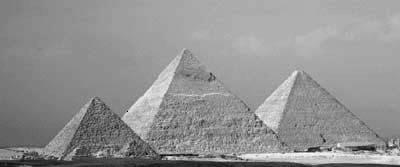
To find my answer, once again I had to turn to the Noble Qur`aan. As I have quoted this verse before;
"Fir'uan
(Pharaoh) said: "...set up for me a Srhan (a lofty tower or a palace)
in order that I may (climb) look at (or look for) the Allah of Moses;
and verily, I think that he (Moses) is one of the liars."
(Sura 28. Al-Qasas Section 4 verse 38)
There is no apparent answer in the translation but the famous Mufaseer (commentator of the Qur`aan), Imam Bagh'we writes;
Allah سبحانه التعالئ wanted to test these people after the completion of the structure. Fir'uan and his comrades climbed on the summit when they reached the top he gave an order to his archers to shoot arrows towards the heavens when the arrows returned they were stained in blood, upon seeing this, Fir'uan turned to his people and shouted, 'I have killed the God of Prophet Musa عليه السلام.
When dusk draw near Allah سبحانه التعالئ gave order to Jibraiel (Peace be upon him) to destroy the people on the summit. Jibraiel (Peace be upon him) struck the summit, the peak shattered into three parts one of the parts fell on the army of Fir'uan which was completely destroyed another part fell in the sea the third part fell towards the west destroying all those who were involved in the construction of this huge structure. [2]
These people who abandoned the town might have sensed that a catastrophe is inevitable and ran for shelter but no one can run away from the calamity of Allah سبحانه التعالئ in the end they were all destroyed. This is where the third part might have fallen.
What Was Used To Build the Pyramids
As in Egypt, there are very few places were stone and wood can be found so the only place the Pharaohs could turn to was the great river Nile. The river Nile's flood basin and the Nile delta gave the Pharaohs a material, which was easy to obtain, and almost never ending, mud and clay. But mud and clay alone were not stronger enough to sport the huge Pyramids weight. So they had to dry the mud or boil it on fire and bake brick form it. The Noble Qur`aan relates to us in the following words;
"Fir'uan (Pharaoh) said: "O chiefs! I know not that you have an Allah other then me. So kindle for me (a fire), 'O' Hamman, to bake (bricks out of) clay, and set up for me a Srhan (a lofty tower or a palace)..."
(Sura 28. Al-Qasas Section 4 verse 38)
In this Qur`aanic verse it is clear that the first material they used was mud and clay then the Pyramids were covered with limestone to stabilize them.
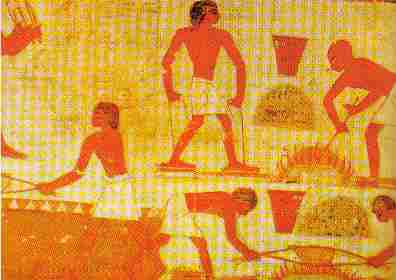
"In this picture depicts technical preparation of slaves, thought
to be the Children of Israel, before setting to work on a construction
project. The slaves are making bricks by boiling mud on fire, and preparing
mortar". [6]
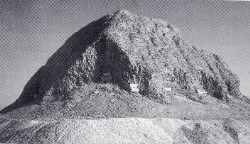
"The mud brick inner structure of Senusret II's pyramid at Lahun was stabilized by stone cross walls. Once the outer limestone casing had been robbed, however, the inner core swiftly deteriorated". This was in 1895 BC. Not only Senusret II built these Pyramids with mud brick inner structure but his son Amenemhet III did the same. [7]
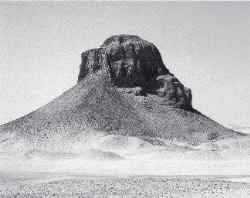
"Once the outer limestone casing of the middle kingdom Pyramids was robbed away, the mud brick interior core soon became an eroded mass, as here with the Pyramids of Amenemhet III at Dahshur. [8]
All this proves only one thing, which you might have guessed by now, that the Pyramids were once built by mud bricks thus making the Noble Qur`aan evidential. Also confirmed one more time the fact that the Qur'aan comes from Allah سبحانه التعالئ. In a miraculous way, the Qur'aan conveys to us historical information that could not have been possessed or understood at the time of the Prophet صلى الله عليه و سلم.
Which Fir'uan Was It and Who Is Hamman
There have been about nearly 170 or more Pharaohs stretched back to 3100 BC. So it is very hard to pin point the exact Pharaoh which lived at the time of Prophet Musa (May Peace of of Allah be on him). But there is only one Prophet Musa عليه السلام thus if we can determine the date of Prophet Musa عليه السلام then we will know which Fir'uan it was. Then again, we cannot look in any other calendar other then the Islamic the reason being, Islamic calendar is the only accurate record we have. The Jewish and the Christian calendars have faults in them, from their foundation and have been corrected many times in history. For example the first CE (Common Era) did not start from a 'zero' because Roman numerals don't have a Zero, and then came the Julian calendar which was introduced by Julius Caesar (100 or 102-44 BC).
Since the time which the earth takes to complete its orbit is 365 days, 5 hours, 48 minutes and 46 seconds, in the Julian calendar a year was about eleven minutes longer than a solar year. The resulting cumulative error became about ten days by the close of the sixteenth century, which was rectified in 1582 by Pope Gregory X111 (1502-85), who ordained that 5 October in that year be called 15 October. In order to prevent further accumulation of error, he also ordered that while each year divisible by four should contain 366 days, as in the Julian calendar, centenary years should be counted as Leap years only if they are divisible by 400. Thus, 1600 was a Leap year but not 1700, 1800 or 1900, while 2000 CE will be a Leap year. It is this modified version, known as the Gregorian calendar, which is in use now.
Different countries adopted the calendar at different times. Great Britain (including her Dominions), for instance, did not adopt it until 1752, by which time she found herself eleven days behind the rest of Europe which was rectified by 3 September being reckoned as 14 September. It was adopted by Italy, France, Spain, Portugal and Luxembourg in 1582, Poland in 1586, Japan in 1872, China in 1912, Turkey and Soviet Russia in 1918 and by Greece as late as 1923.
Islamic calendar hasn't gone through any modifications and has been consistent since its inauguration, so because of this and many other reasons I have chosen Islamic sources for dating.
In the famous Tafseer (commentary of the Noble Qur`aan) of Jalal'an its mentioned, from the source of Alama Saueti that the gape between Prophet Musa عليه السلام and Prophet Dawood عليه السلام is 569 or 579 years and Prophet Suleiman عليه السلام lived for 59 years of age. The gape between Prophet Suleiman عليه السلام, from his demise to the birth of our Prophet Muhammad صلى الله عليه و سلم is 1700 years. Keeping all these important year gaps in mind, we can work out the approximate dates of all the Prophets that are mentioned. [9]
In this time line I have used a lunar dating system which is 11 days shorter every year from solar calendar so the solar year at 1739BC from 0BC will be, 1686BC (Approx.). The Pharaoh mentioned in books who lived at this time is Neferhotep II but there is no mention of Prophet Musa عليه السلام however it known to be the second intermediate period of the fourteenth dynasty. Either the dating system of the modern Egyptologists is wrong in respect to Prophet Musa (May Peace of of Allah be on him) or this event of Prophet Musa عليه السلام was a minor affair in Egyptian annals. There are few events corroborated by ancient Egyptian records regarding this affair.
It is known commonly that it was Ramesses II (1279-1212) who dealt with Prophet Musa عليه السلام. But Ramesses II's date does not coincide with Prophet Musa عليه السلام. Determining the date of Prophet Musa عليه السلام gives us the time but does not tell us accurately which Pharaoh lived then. Relying on the common theory of Ramesses II being the Pharaoh proves nothing.
I had to look for some one else, a third person. This led my search to the third person that is mentioned in the Noble Qur`aan together with Fir'uan, which of course is 'Hamman' who is mentioned in the Noble Qur`aan six times, Surah 28:6, 8 and 38 Surah 29:39 Surah 40:24 and verse 36.
[This is an extract from the works of Harun Yahya] [10]
Surprisingly the name of Hamman is never mentioned in those sections of the Torah pertaining to the life of Prophet Musa عليه السلام. However, the mention of Hamman can be found in the last chapters of the Old Testament as the helper of a Babylonian king who inflicted many cruelties on the Israelites approximately 1,100 years after Prophet Musa عليه السلام.
Some non-Muslims, who claim that the Prophet Mohammed صلى الله عليه و سلم wrote the Qur'aan by copying from the Torah and the Bible, also assert that during the process, he transferred some of the subjects related in these books into the Qur'aan incorrectly.
The absurdity of these claims was demonstrated only after the Egyptian hieroglyphic alphabet had been deciphered, approximately 200 years ago, and the name "Hamman" discovered in the ancient scripts. Before these discoveries, the writings and inscriptions of ancient Egypt could not be understood. The language of ancient Egypt was hieroglyphic, which survived through the ages. However, with the spread of Christianity and other cultural influences in the 2nd and 3rd centuries CE, Egypt forsook its ancient beliefs as well as hieroglyphic writing.
The last known example of the use of hieroglyphic writing was an inscription dated 394 CE. Then that language was forgotten, leaving nobody who could read and understand it. And that was the situation until some 200 years ago…
The mystery of ancient Egyptian hieroglyphics was solved in 1799 by the discovery of a tablet called the Rosetta Stone dating back to 196 B.C. The importance of this inscription was that it was written in three different forms of writing: Hieroglyphics, demotic (a simplified form of ancient Egyptian hieratic writing) and Greek. With the help of the Greek script, the ancient Egyptian writings were decoded. The translation of the inscription was completed by a Frenchman named Jean-Françoise Champollion. Hence a forgotten language and the events related in it were brought to light. In this way, a great deal of knowledge about the civilization, religion and social life of ancient Egypt became available.
Through the decoding of hieroglyph, an important piece of knowledge was revealed: the name "Hamman" was indeed mentioned in Egyptian inscriptions. This name was referred to in a monument in the Hof Museum in Vienna. [11]
In the dictionary of "People in the New Kingdom," that was prepared based on the entire collection of inscriptions, Hamman is said to be "the head of stone quarry workers". [12]
The result revealed a very important truth. Unlike the false assertion of the opponents of the Qur'aan, Hamman was a person who lived in Egypt at the time of Prophet Musa عليه السلام, who had been close to the Pharaoh, and had been involved in construction work, just as imparted in the Qur'aan.
Furthermore, the verses in the Qur'aan describing the event where the Pharaoh asked Hamman to build a tower, is in perfect agreement with this archaeological finding.

Statue
of Hamon, Khufu's master builder, Hildesheim Museum.
The chief of works thought to have been Pharaoh Khufu's cousin Hemon
who's statue was discovered in the mastaba tomb close by his masterpiece.
[13]
From this we learn that the Pharaoh responsible for building the Great Pyramid was Khufu and his cousin Hamman but there is absolutely no evidence to suggests that Khufu was the Fir'uan that is mentioned in the Noble Qur`aan but that does not rule him out for not being either. What we can say is that Hamman does provide us with information conforming that Srhan has to be the great Pyramid of Giza.
In conclusion, the existence of the name Hamman in the ancient Egyptian inscriptions not only rendered the fabricated claims of the opponents of the Noble Qur'aan worthless, but also confirmed one more time the fact that the Qur'aan comes from Allah سبحانه التعالئ. In a miraculous way, the Noble Qur'aan conveys to us historical information that could not have been possessed or understood at the time of the Prophet صلى الله عليه و سلم.
The Noble Qur`aan proved to us that it has the answers we need and is the only revelation of Allah سبحانه التعالئ which is unaltered. Therefore, we need to explore it very carefully and attentively what the Noble Qur`aan relates to us and contemplate it.
-------------------------------------------------------------
-
Keys to the Temple, David Furlong page 71
-
Tafseer Mazhari (Urdu) Vol.9 Page 118
-
Tafseer Mazhari (Urdu) Vol.10 Page 232
-
Keys to the Temple, David Furlong, page 76
-
Peter A Clayton, Chronicles of the pharaohs, page.83
-
Harun Yahya Perished Nations page, 98
-
Peter A Clayton, Chronicles of the Pharaohs, page 83
-
Peter A Clayton, Chronicles of the Pharaohs, page 89
-
Tafseer Jalal'an page 275 (hashia) footnote 8
-
http://www.harunyahya.com/50_the_word_haman.php
-
Walter Wreszinski, Aegyptische Inschriften aus dem K.K. Hof Museum in Wien, 1906, J. C. Hinrichs' sche Buchhandlung
-
Hermann Ranke, Die ?gyptischen Personennamen, Verzeichnis der Namen, Verlag Von J. J. Augustin in Glückstadt, Band I, 1935, Band II, 1952
-
Peter A Clayton, Chronicles of the pharaohs, PG.47
I KHAN 10/07/03 ©
Website: www.ClassicalIslam.com
E-mail: ![]()